Hands on with Outlook for Android
Microsoft has released a dedicated Outlook app to the Google Play store for Android devices 4.1 and above (there is also a similar client for iOS). Their description of the app states:
"Outlook is a free email app that helps you get more done from anywhere with one unified view of your email, calendar, contacts, and attachments. Outlook automatically surfaces your most important messages - across all your email accounts. Swipe to quickly delete, archive, or schedule messages you want to handle later. Easily view your calendar, share available times, and schedule meetings. And attach files from your email, OneDrive, or Dropbox with just a few taps.
Outlook works with Microsoft Exchange, Office 365, Outlook.com (including Hotmail, MSN), Gmail, Yahoo Mail, and iCloud."
I use the default email client on my Samsung Galaxy S5 for both my business (Activesync) and personal (IMAP) email, but I was curious about what the Outlook app (technically a preview; the iOS version is more advanced) had to offer. My company uses Exchange 2010, which is supported by the Outlook app; the oldest in-house version of Exchange it will work with is 2007.
I went to the Google Play store, located the app, clicked install and within a few minutes Outlook appeared on my Samsung Galaxy S5.
Adding an account was pretty much the same as with the Android mail app:
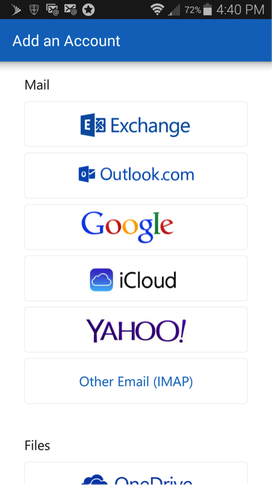
Image: Scott Matteson
I chose "Exchange" then entered my business email address, server name, domain name and password. The configuration process completed successfully. It took a while for the contents of my INBOX to appear, but then it did with lots of glorious colorful icons:

Image: Scott Matteson
At first the letters in the tiles threw me for a loop then I realized they represent the individuals of the sender. Color coding seemed random; I was assigned the color orange and a coworker was purple.
Further experimentation as I proceeded to work normally through email showed me messages in conversational format:

Image: Scott Matteson
My fellow Tech Republic columnist Tony Bradley covered some of the Outlook app functions such as Focused Inbox, file attachments/cloud integration (you can access Dropbox, Box and of course OneDrive files via the Outlook app), and calendar/scheduling features in his article, "5 reasons to love the new Outlook for iOS and Android apps." I won't retrace his steps with the exception of providing screenshots to get a closer look at the "Focused Inbox" function, which is probably the most noteworthy element to the app.
Focused Inbox is intended to sort out a lot of "less relevant" email such as whitepapers or newsletters to provide you with a streamlined view of the mail you need to see. You have to go to Settings (the icon representing three vertical dots in the upper right) to turn it on by dragging the horizontal lever to the right:
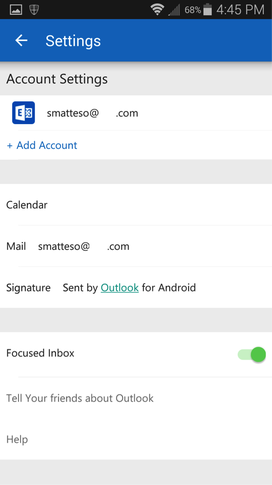
Image: Scott Matteson
Once you return to your INBOX, Outlook then provides you with a set of "tabs" along the top of the screen:
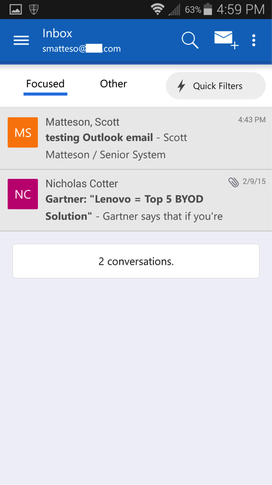
Image: Scott Matteson
My Focused Inbox is now a lot less cluttered, since many of the newsletters and webinar emails have been moved to the "Other" INBOX:

Image: Scott Matteson
You can move items from one location to the other and Outlook will adjust accordingly for next time.
I then explored the app to see what it could do. Here are my impressions.
The good
The normal functions we expect from email applications were present and working. Handling and responding to emails worked quite well. I could swipe to the right or left to conduct operations such as archiving, deleting, moving or marking items as read/unread. Searching worked as expected. The Outlook app offers a "schedule email" option which is essentially like a snooze alarm; it takes items out of your INBOX until a specified time you can pick. I like that since I don't consider my day finished until my INBOX is empty.
I had full access to my email folders:
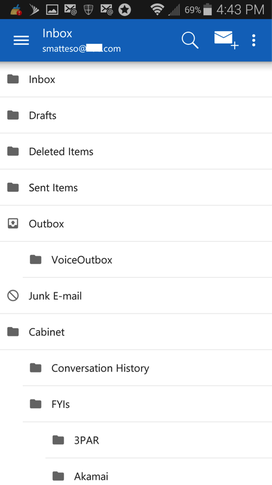
Image: Scott Matteson
I could access my calendar:

Image: Scott Matteson
Accepting meeting requests sent via email was straightforward:
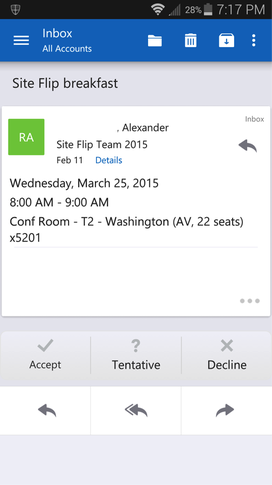
Image: Scott Matteson
I could see addresses for several of my coworkers via the "People" tab:
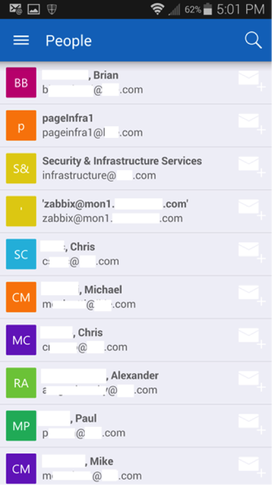
Image: Scott Matteson
What was nice about this function was that it automatically grouped the people I contact the most near the top; my boss and team members for instance.
Settings to customize notification options are also available:
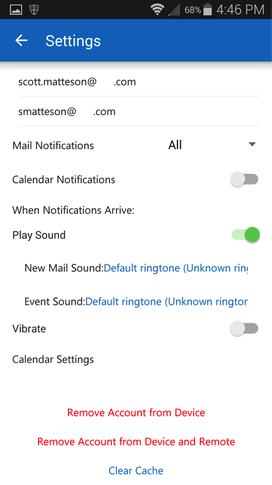
Image: Scott Matteson
The Outlook app also has a robust help feature that explains many of the details quite comprehensively:

Image: Scott Matteson
The "Files" tab is handy since it shows you all recent files which you have sent/received for easy access:
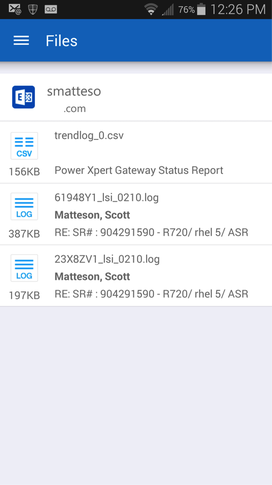
Image: Scott Matteson
One other interesting element is the praise the app levies upon you for cleaning out your INBOX. I got mine down to zero messages and it applauded me with the following:

Image: Scott Matteson
Another empty-inbox "bravo" stated: "Achievement unlocked: Inbox Zero (500 points)".
Kind of a quirky and fun little inclusion into the program, right? Well, as is often the case, when companies try to add a little zest to their products it seems to come at the expense of other functions.
The bad
There are a few elements are missing from the Outlook app preview, based on my experience and reviewers of the app on the Google Play store:
I could only set up one account in Outlook - my business account which connects to Exchange 2010. I could not connect to my personal email account using IMAP since the app doesn't seem to support that.
Limited calendar view choices
No ability to attach files from an SD card
No ability to create filters or folders
No ability to select multiple messages
No ability to set mail push/pull options or otherwise trigger email synchronization
No available out of office options
No option to empty trash
No task integration
Secondary folders don't sync automatically
Some users have reported issues with notifications not working as expected
The people list can't be reordered nor can items be deleted from it; it's not really a full "Contacts" file
Not only that, but my Outlook settings disappeared entirely two days after configuring the app, and I wasn't able to successfully reconfigure it; the app kept producing invalid authentication errors although nothing had changed on the Exchange side nor with my credentials. Fortunately, I felt I'd gained enough exposure to it to understand the program and complete this review, but this was an unexpected twist of events that didn't bode well for its reliability. I'm not alone on this, either: numerous reviewers reported the same unpleasant experience.
The ugly
When it works, the Outlook app seems functional enough from a minimalistic perspective, but it is not without some significant security concerns. As another Tech Republic colleague Erick Eckel pointed out, the Outlook app doesn't adhere to ActiveSync password requirement policies and stores your e-mail and credentials on outside servers (supposedly to speed up delivery). In fact, the app is now being actively blocked by some companies and governmental agencies (one such entity is the European Parliament, according to news.softpedia.com) due to these issues. Microsoft has said they will address the issue of Activesync policies but there is no word yet on the critical issue of storing data and password information elsewhere. That makes it a no-go, hands-down, for many organizations that prohibit storing company data and/or credentials elsewhere.
Summary
As a basic mail client, the Outlook preview app will serve the needs of many. Keep in mind it's a new product and likely to undergo change and evolution over time. I'll be sticking with my default email app (at the moment I have no choice, since Outlook stopped working for me entirely) but others may have better luck. I give it two out of five stars, but we'll see if Microsoft does better in the next round and can meet more expectations.
Also see:
5 reasons to love the new Outlook for iOS and Android apps
ZDNet: Microsoft rolls out new Outlook apps for iOS and Android
Apple users should stick to iOS Mail
Five new Android apps that could help make your day a bit more productive

 Yahoo News
Yahoo News 
